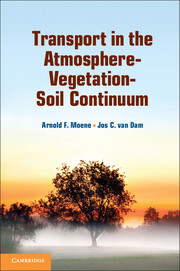Book contents
- Frontmatter
- Contents
- Preface
- 1 The Atmosphere-Vegetation-Soil System
- 2 Available Energy: Net Radiation and Soil Heat Flux
- 3 Turbulent Transport in the Atmospheric Surface Layer
- 4 Soil Water Flow
- 5 Solute Transport in Soil
- 6 Vegetation: Transport Processes Inside and Outside of Plants
- 7 Combination Methods for Turbulent Fluxes
- 8 Integrated Applications
- 9 Integrated Models in Hydrology and Meteorology
- Appendix A Radiation
- Appendix B Thermodynamics and Water Vapour
- Appendix C Dimensional Analysis
- Appendix D Microscopic Root Water Uptake
- Appendix E Crop Factors for Use with Makkink Reference Evapotranspiration
- Answers
- List of Main Symbols
- References
- Index
6 - Vegetation: Transport Processes Inside and Outside of Plants
Published online by Cambridge University Press: 05 June 2014
- Frontmatter
- Contents
- Preface
- 1 The Atmosphere-Vegetation-Soil System
- 2 Available Energy: Net Radiation and Soil Heat Flux
- 3 Turbulent Transport in the Atmospheric Surface Layer
- 4 Soil Water Flow
- 5 Solute Transport in Soil
- 6 Vegetation: Transport Processes Inside and Outside of Plants
- 7 Combination Methods for Turbulent Fluxes
- 8 Integrated Applications
- 9 Integrated Models in Hydrology and Meteorology
- Appendix A Radiation
- Appendix B Thermodynamics and Water Vapour
- Appendix C Dimensional Analysis
- Appendix D Microscopic Root Water Uptake
- Appendix E Crop Factors for Use with Makkink Reference Evapotranspiration
- Answers
- List of Main Symbols
- References
- Index
Summary
Plants serve as an intermediary between the atmosphere and the soil: they efficiently transport soil moisture into the air and at the same time ingest atmospheric CO2 for their growth. This chapter deals with the transport of water inside plants (from the root to the stomata), the link between water uptake and dry matter production and the modification of the near-surface atmosphere by vegetation, including microclimate, dew and rainfall interception.
Functions of Water in the Plant
Water performs many essential functions within plants. As a chemical agent, water facilitates many chemical reactions, for instance in assimilation and respiration. Water is a solvent and a transporter of salts and assimilates within the plants. Water enables the regulatory system of the plant, as it carries the hormones and substances that are required for plant growth and functioning. Water confers shape and solidity to plant tissues. If the water supply is insufficient, herbaceous plants and plant organs that lack supporting tissue will lose their strength and wilt. The hydrostatic pressure in cells depends on their water content and permits cell enlargement against pressure from outside, which originates either from the tension of the surrounding tissue or from surrounding soil. The large heat capacity of water greatly dampens the daily fluctuations in temperature that a plant leaf may undergo, due to the considerable amount of energy required to raise the temperature of water. Energy is also required to convert liquid water to vapour that transpires from leaves, causing cooling due to evaporation. Without these temperature compensating effects, plants would warm up much more and eventually die from overheating. Owing to these effects, transpiration rates can be estimated from surface temperatures, obtained by infrared thermography using remote sensing from aeroplanes or satellites (Ehlers and Goss, 2003).
- Type
- Chapter
- Information
- Transport in the Atmosphere-Vegetation-Soil Continuum , pp. 200 - 251Publisher: Cambridge University PressPrint publication year: 2014



